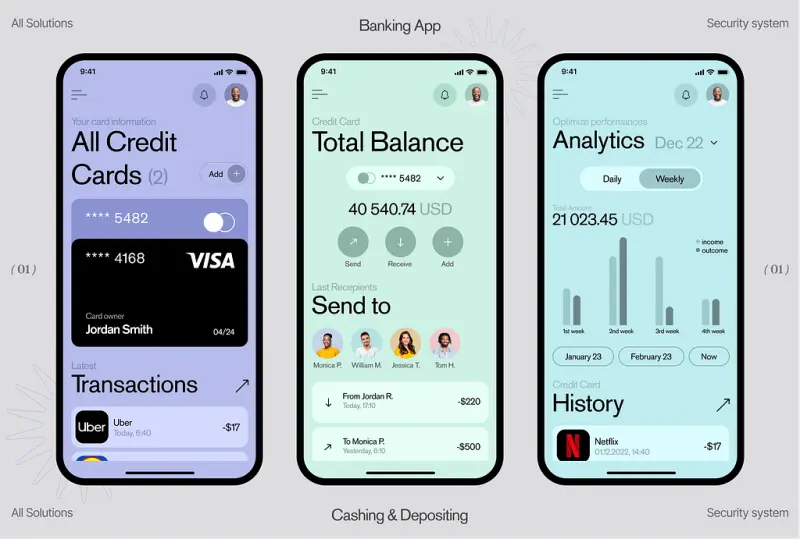Cloud Computing in Banking: A Game-Changer for Efficiency
- TECHVIFY Team
- 0 Comments
The banking and financial services industry is still trying to catch up when it comes to meeting changing consumer needs, especially in the digital space. A recent survey shows that 59% of consumers now expect better customer service than they did a year ago, with 80% saying that a company’s overall experience is just as important as its products and services.
Some institutions are already starting to make changes. According to a recent report from Gartner, application modernization is now the top priority for cloud computing in banking and investment services. In fact, 70% of banking respondents said they plan to increase their cloud spending in 2022.
In this article, we’ll look at the benefits and challenges of cloud computing in banking industry and provide some best practices for banks to adopt and manage cloud solutions successfully.
I. Understanding Cloud Computing in the Banking Sector
Cloud computing represents a game-changing technology that has significantly impacted how banks handle their data. By utilizing cloud services, banks can now access a variety of IT solutions and software applications that enhance their operational efficiency and encourage innovation.
Cloud computing for Banking industry
With the cloud, banks can move away from maintaining large-scale in-house data centers and avoid the hefty investments in hardware and software that were once necessary. Instead, they can adopt a flexible pay-as-you-go model, allowing them to access the resources they need and adjust their resources up or down as needed to meet demand. This approach makes banks more adaptable to evolving business needs, all while eliminating the upfront expenses and ongoing maintenance associated with traditional IT systems.
II. Key Advantages of Cloud Computing in Banking and Financial Services
Cloud computing offers financial institutions numerous advantages, such as enhanced fraud detection, lower operational costs, improved security, regulatory compliance, better customer relationship management (CRM), and increased scalability.
Enhanced Fraud Detection with Cloud Computing
Fraud in the banking industry can take many forms, including identity theft, fraudulent loan applications, direct theft, fake accounts, money laundering, tax evasion, and speculative trading.
By using cloud technology, banks can process and process large datasets from various sources, which helps them identify suspicious activities early on. This enables them to take preventive measures before any significant damage occurs.
Cost Efficiency Through Cloud Computing
Cloud computing in banking allows financial organizations to reduce their data storage costs by adopting a pricing model where you only pay for what you use, removing the need for significant upfront investments in on-premise systems.
Cloud providers take care of the administration and upkeep of data storage, which not only reduces the need for expensive IT infrastructure but also minimizes the requirement for large IT support teams.
Strengthened Security Measures with Cloud Services
Banks are obligated to protect the sensitive information they manage. While traditional on-site storage solutions can be effective, they require a highly skilled IT team specializing in data security to ensure customer data remains safe.
Cloud providers, however, adhere to stringent data privacy and security regulations. They implement multiple layers of protection, safeguarding sensitive information from cyber-attacks and data breaches, giving banks an extra level of security.
Cloud technology in banking
Ensuring Compliance with Industry Regulations
Given the sensitive nature of the data handled by financial institutions, they must comply with various data privacy, security, and regulatory laws.
Cloud storage providers follow strict guidelines to ensure data privacy and security, giving financial institutions confidence that they are adhering to industry regulations and standards.
Improved Customer Relationship Management (CRM) via the Cloud
Banks can utilize cloud-based CRM tools to consolidate and organize customer information in a single location, simplifying track and analyze customer interactions.
In today’s environment, 73% of customers expect businesses to recognize their unique needs, preferences, and expectations. By implementing the right cloud strategies, banks can offer personalized services that meet their customers’ demands.
Enhanced Scalability for Financial Institutions
In the past, banks and other financial institutions had to purchase infrastructure designed to handle peak demand periods. However, with cloud computing, these organizations now have the flexibility to scale their resources up or down as needed.
During periods of increased demand, such as the holiday season or fiscal year-end, financial institutions can automatically adjust their computing capacity, optimizing operations and preventing the overuse or underuse of resources.
Looking to Outsource Development?
Contact TECHVIFY – Vietnam’s Leading Offshore Software Development & Outsourcing Company, for consultation and development services.
III. Addressing the Challenges of Cloud Computing in the Banking Industry
Although cloud computing brings significant advantages to the banking sector, it also introduces a set of unique challenges that banks must navigate to ensure the security, reliability, and compliance of their IT systems. In this section, we will explore several key challenges banks face when adopting cloud solutions, including latency issues, data residency concerns, and resilience risks. We will also discuss potential strategies to mitigate these challenges effectively.
Managing Latency in Cloud Computing
One of the most pressing challenges in cloud computing for banks is latency, which refers to the delay in data transmission between users and data centers. In banking applications, even minor delays can affect the performance of services and hinder the user experience.
To reduce latency, banks should consider optimizing their network infrastructure and selecting cloud providers with data centers that are geographically closer to their users. This proximity can help ensure faster data transfer and enhance overall system performance.
Cloud computing in Banking sector
Navigating Data Residency Requirements
Banks often face legal obligations to store and process customer data within the country or region where the data originates. This presents challenges for banks that wish to leverage cloud services with data centers located in different regions.
To address this, banks should prioritize working with cloud providers that offer data residency options. Additionally, they must ensure that customer data is stored and handled in compliance with local laws and regulations. This may involve collaborating closely with cloud providers to guarantee adherence to the required data residency standards.
Ensuring Resilience in Cloud Infrastructure
Relying solely on a single cloud provider or data center can introduce new points of failure that may compromise a bank’s IT infrastructure. To mitigate these risks, banks should consider adopting a multi-cloud strategy, which involves using multiple cloud providers to distribute services and applications across various data centers and locations.
By implementing a multi-cloud approach, banks can boost the resilience of their infrastructure, ensuring that they are better equipped to handle potential outages or disruptions.
To effectively address these challenges, banks must adopt a comprehensive cloud strategy. This includes selecting a reliable cloud provider with strong security measures, implementing best practices for data governance, and ensuring compliance with regulatory standards. By doing so, banks can fully harness the benefits of cloud computing while safeguarding the privacy and security of customer data. In the next section, we will dive deeper into the considerations for choosing the right cloud provider for banking.
IV. Tips to Choose the Right Cloud Provider for Banking: Key Considerations
Choosing the ideal cloud provider is critical for banks and financial institutions looking to leverage cloud technology. In this section, we will examine the most important factors banks should consider when evaluating cloud providers, and we will highlight some of the top cloud options available.
1. Prioritizing Security and Compliance
In the financial services industry, security is crucial due to the highly sensitive nature of customer data and financial transactions. Cybersecurity threats are a constant concern and compliance with industry regulations is mandatory. Banks should focus on robust security features like encryption, access controls, and intrusion detection systems when evaluating cloud providers. Additionally, cloud providers should hold relevant security certifications, such as SOC 2, ISO 27001, and PCI DSS.
Furthermore, banks must ensure that their chosen cloud provider adheres to industry-specific regulations, such as GDPR for data protection in Europe and FFIEC guidelines for the U.S. financial sector. Compliance with these regulations helps banks maintain trust and meet legal obligations.
2. Ensuring Scalability and Optimal Performance
Banks operate in a fast-paced environment where the demand for computing resources can fluctuate. Therefore, scalability and performance are key considerations when selecting a cloud provider. Banks need cloud platforms that offer elastic scalability, allowing them to expand or reduce their infrastructure as needed, without disruptions.
Additionally, banks should evaluate the cloud provider’s performance capabilities, such as network latency, data throughput, and service availability. A reliable provider will offer clear performance guarantees through service-level agreements (SLAs) to ensure consistent uptime and responsiveness.
Cloud computing in Banking
3. Evaluating Cost and Pricing Models
Cost efficiency is another critical factor for banks adopting cloud solutions. Financial institutions are often looking to streamline their IT spending while maximizing value. When assessing cloud providers, banks should compare different pricing models, including pay-as-you-go, subscription-based, and usage-based options.
It’s also essential to consider additional costs, such as data egress fees, storage expenses, and fees for extra services like analytics or databases. By calculating the total cost of ownership (TCO), banks can make better-informed choices about which cloud solution fits their budget and needs.
4. Handling Data Sovereignty and Residency
Data sovereignty involves the legal obligations that dictate where customer data can be stored and processed. Many financial institutions must comply with local regulations that restrict where data can reside. Banks should ensure that their cloud provider offers data centers in regions that meet these residency requirements.
Moreover, banks should verify the cloud provider’s data management practices, including encryption, data segregation, and backup procedures. These measures are critical in ensuring that data sovereignty is maintained and customer information remains protected.
5. Reviewing Service-Level Agreements (SLAs)
Service-level agreements (SLAs) are essential contracts that define a cloud provider’s commitments to performance, availability, and support. When selecting a cloud provider, banks should carefully review the SLAs to understand the guarantees around service uptime, response times for technical support, and potential penalties for service disruptions.
A robust SLA will ensure that the cloud provider is accountable for maintaining the agreed-upon service levels, giving banks peace of mind that their operations will remain uninterrupted.
By considering these factors—security, scalability, cost, data sovereignty, and SLAs—banks can make an informed decision when selecting the cloud provider that best aligns with their operational and regulatory needs.
Conclusion
Cloud computing in banking offers the tools needed to enhance customer experiences, streamline operations, and strengthen resilience. However, overcoming challenges like latency, data residency, and infrastructure resilience is key to fully realizing these benefits.
By choosing the right cloud solutions, banks can ensure they’re keeping up and leading the way in innovation and service. Modernizing your IT infrastructure isn’t just about staying competitive—it’s about delivering the kind of customer experience that today’s market demands.
Ready to embrace the future of banking? TECHVIFY is here to help. Our expert team can assist you throughout the process, making cloud adoption seamless, secure, and tailored to your specific needs. Let’s work together to take your financial institution to the next level.
Get in touch with us at TECHVIFY today—let’s start building the future of your business!
TECHVIFY – Global AI & Software Solutions Company
For MVPs and Market Leaders: TECHVIFY prioritizes results, not just deliverables. Reduce time to market & see ROI early with high-performing Teams & Software Solutions.
- Email: [email protected]
- Phone: (+84)24.77762.666









